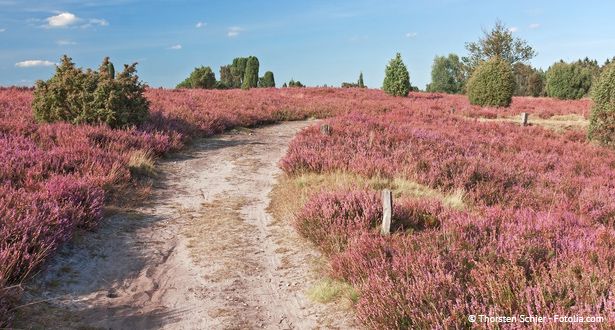Heathland – peace and space
Heathlands were widespread in Europe centuries ago. Today, they are rarely found and it requires constant effort to preserve them.
The heathland attracts many visitors to the region, especially for the heather blossoming. After their stay, visitors return home mainly impressed by the peace and openness of the landscape.
Kein Klang der aufgeregten Zeit drang noch in diese Einsamkeit.
(Quote: Theodor Storm)
But how did the heathland actually develop? How did the farming industry work? Why is Lüneburg Heath not as flat as is generally accepted? Why is there sometimes burning on the heathland and why does heavy machinery travel over the heathland? Why is the Schnucke (German grey heath) sheep so useful for the landscape? Why does heather grow here, and why do juniper, black grouse and nightjar do so well here? Answers to these questions can be found at:
Jetzt fängt das schöne Frühjahr an, und alles fängt zu blühen an auf grüner Heid und überall. Es blühn Blümlein auf dem Feld, sie blühen weiß, blau, rot und gelb, es gibt nichts schöneres auf der Welt.
Quote: German folk song
Exploring the heathland
There are diverse opportunities to explore the heathland in the Nature Park. They include, for example:
- walks through smaller heathland areas such as Marxener Paradies or the Heather Garden in Schneverdingen,
- longer walks through the Nature Reserve, e.g. to car-free Wilsede and to Wilseder Berg,
- horse carriage rides offered by certified companies,
- nature and landscape tours for target groups,
- heather blossom festivals in the region,
- as well as visits to shepherds and their Schnucken sheep.
Find the right one for you! Any further questions about the heathland? Then send us an e-mail to info@naturpark-lueneburger-heide.de. We will try to answer your question.

![[Translate to Englisch:] Siegel: Europäische Union – Europäischer Fond für regionale Entwicklung.](/fileadmin/_processed_/d/6/csm_europaeische-union-fond-regionale-entwicklung-logo_50eda43563.gif)
![[Translate to Englisch:] Logo Europa für Niedersachsen.](/fileadmin/_processed_/b/e/csm_europa-fuer-niedersachsen-logo_7b3947c73c.gif)
![[Translate to Englisch:] Logo Leader.](/fileadmin/_processed_/c/5/csm_leader-logo_c9a57e9ee0.gif)
![[Translate to Englisch:] Siegel: Europäische Union – Europäischer Landwirtschaftsfond für die Entwicklung des ländlichen Raums.](/fileadmin/_processed_/4/7/csm_europaeischer-landwirtschaftsfond-logo_ce24e54bf4.gif)
![[Translate to Englisch:] Logo touristischer Partner Lüneburger Heide.](/fileadmin/_processed_/4/3/csm_lueneburgerheide_positiv-mit-schatten_logo_00411b91a8.gif)